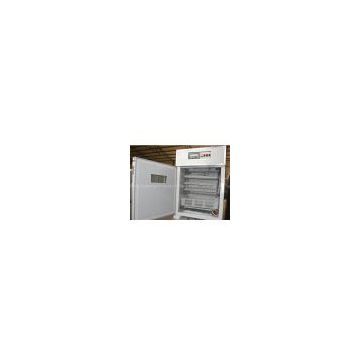Ostrich Egg Incubator
Product description
Product Description
Chicken(Pigeon) Egg Capacity:264 pcs
Duck(Turkey) Egg Capacity:189 pcs
Ostrich Egg Capacity: 6 pcs
Quails Egg Capacity: 663 pcs
Use Voltage: 220V or 110V
Heater Power: 200W
Size: 0.74*0.67*1.07(M)
Weight: 45kg
Rate of hatchability:98%
Payment :T/T or Western Union
Delivery Time: Within a week after order confirmation
Ostrich incubation technique
| |
|
|
|
|
|
|
|
|
|
|
Tips for incubating ostriches in an incubator
1. collecting eggs and store eggs, choose hatching eggs
Collect the ostrich eggs twice daily. Wear latex gloves when collecting eggs. If the eggs are gathered from the nest each day, greater egg production should result. There is no need to disinfect the eggs, just clean with fine sandpaper if they are dirty. Store the ostrich eggs with the large end up(with the air-cell end up), in the environment of 16-18°C(60-64F°).During storage, the eggs should be turned once every day. Try not to store the ostrich eggs for more than 7 days, otherwise the hatchability will decrease to some extent.
Only choose ostrich eggs with normal size and normal weight. Discard eggs which are dirty, shell-cracked, double yolked, misshapen, oversized or undersized.
Common ostrich eggs parameters:
Length:150mm
Diameter:1135mm
Weight: 1300-1700g
Discard eggs whose weight is less than 1000g or more than 2000g.
2. set the eggs into ostrich incubator
Before setting the eggs, adjust and operate the incubator for 1-2 days for observation, until the temperature and humidity get stable. The eggs should be first warmed to room temperature before being set. Always set the eggs with the large end up. Only clean and sound eggs should be set. Dirt and manure should be gently scraped off or removed with sandpaper. Remember not to use cloth to wipe the eggs because this may force bacteria deeper into the pores of the egg shell, and cause infection.
If washing is needed for heavily dirtied eggs, use warm water containing a sanitizing agent, such as ammonium compounds or compounds containing chlorine, iodine or synthetic phenol.
3. candling ostrich eggs
Candling should be done at weekly intervals to observe the embryonic development process and to identify infertile and dead eggs. Before transfer to hatcher, it is advised to candle the eggs, too. If the incubation process is going in the correct way, a dark shadow should be seen in the egg, and as the time going, the shadow will become darker.
4. Hatching period
When incubated for 40 days, or when the chicks have internally pipped, the hatching eggs should be transferred to hatcher for hatching preparation. In this period, the chorioallantois breath transfers to lung breath. If there is an oxygen deficiency, the embryos could die from suffocation. After transferred to hatcher, more fresh air is available and heat dissipation is better, which will help the embryo to pass the critical stage.
Usually 24 to 48 hours later after internal pipping, the chicks will hatch out. Umbilical cord breaking is very important after breaking shell. If Umbilical cord breaking is not smooth, bacteria are easy to infect the chicks. Self-hatching chicks usually have good umbilical cord breaking, without bleeding. In this case, some iodine can be coated to umbilical cord, and then use infected gauze to tape it up.
Only when the chick ostriches are dry can they be transferred to brooder.
Recommended products


